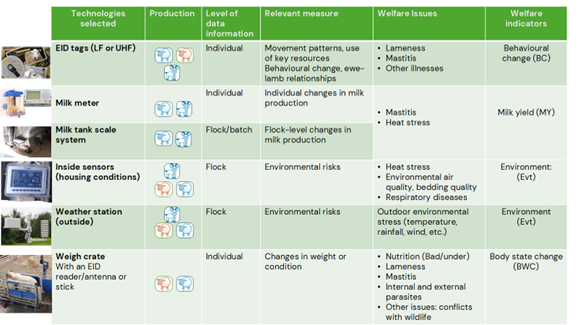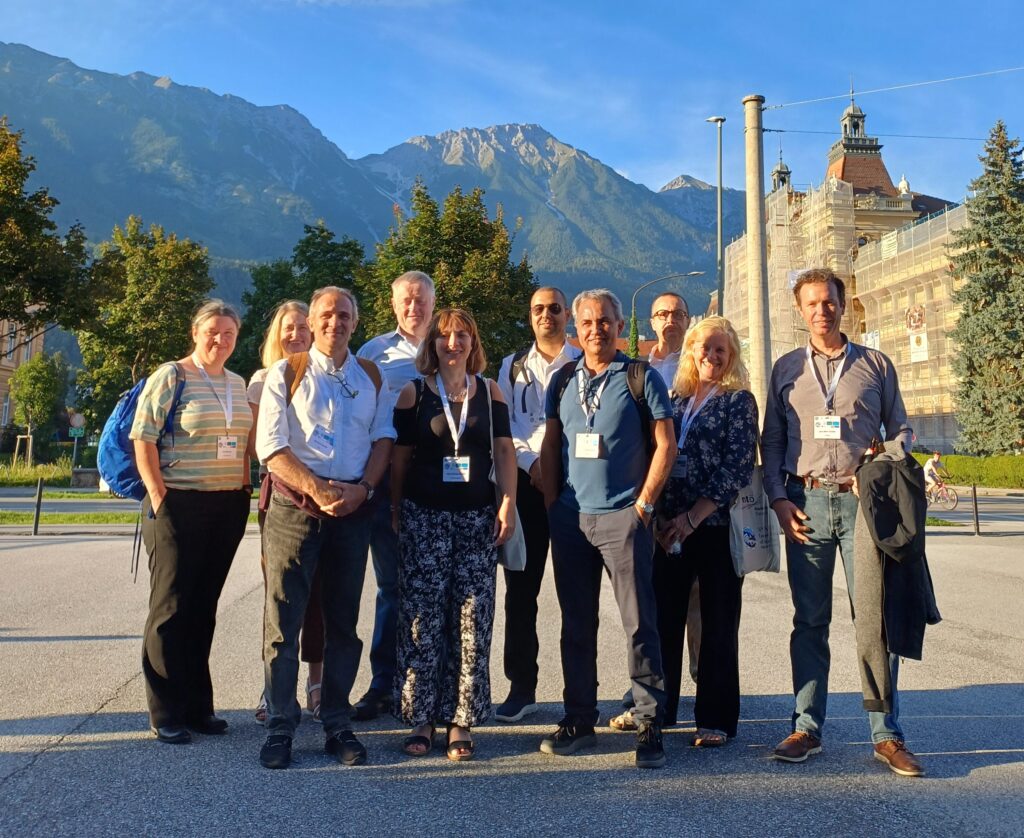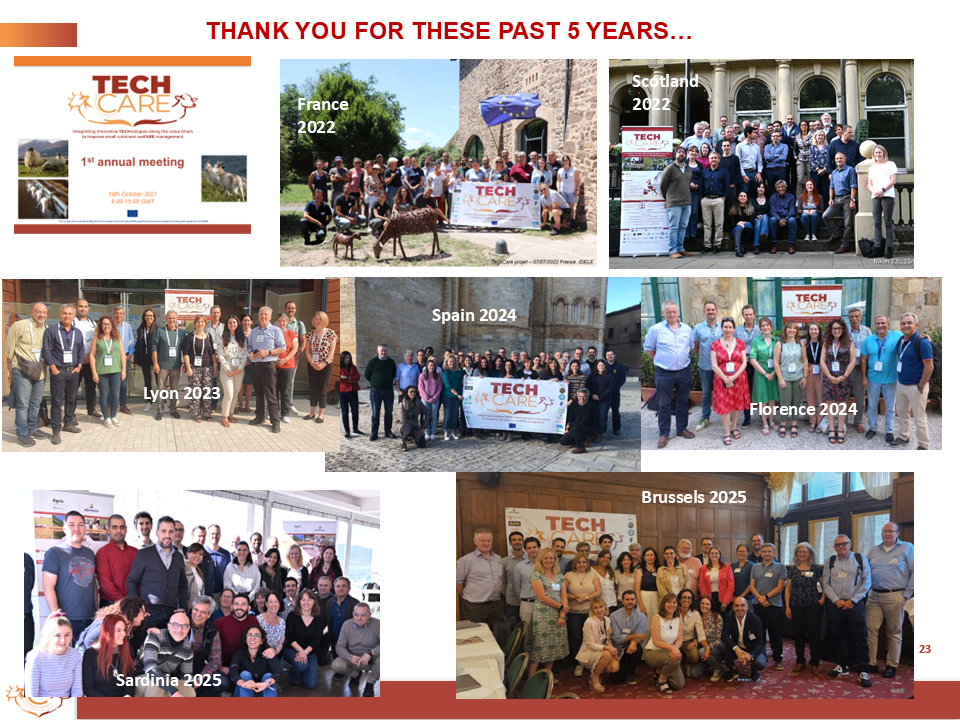– by C. Morgan-Davies (SRUC)
It has been nearly 5 years this month that we embarked on the TechCare project, and what a ride! The project started during Covid19, when everything was held online and lockdown was in force. The first project meetings had to be remote, and it is only in July 2022 that we managed to meet with some of the partners. Our full first annual meeting with everyone was only held in September 2022, in Glasgow, nearly 2 years after the official start!
But despite this, the consortium and partners made it. Let’s reflect on these past years and outcomes.
TechCare – innovations and technologies for small ruminant welfare management
The project aimed to improve the welfare management of small ruminants through innovative and accessible technological solutions for farmers. The project, led by Scotland’s Rural College, comprised 19 partners in 9 different countries. TechCare targeted sheep (milk and meat) and goat (milk) production sectors, taking into account the specificities of each type of production, from farming to transport. Structured in five main steps, TechCare first planned to identify and prioritize animal welfare risk factors by country and sector. Subsequently, the consortium identified promising technologies to manage these risks, before testing them under real conditions in pilot farms. Effective technologies were then validated on a larger scale with willing commercial farmers. Finally, the project developed innovative alert systems enabling proactive management of animal welfare. A key element of the project was the continuous involvement of farmers and stakeholders from the outset. The consortium organized national workshops from the beginning to present the objectives of TechCare, regularly gather feedback from stakeholders, and adapted the project’s strategic choices to their real expectations and needs. This multi actor and collaborative approach ensured both the relevance of the proposed technologies and their impact on the ground.
Identification of welfare priorities in European farming
The project began with a thorough analysis of risk factors affecting the welfare of small ruminants, using the recognized Five Domains model of Mellor et al. (2020) – Nutrition, Health, Environment, Behaviour, Mental State. This step allowed for the identification of over 80 potential risks, covering different phases of production and development of sheep and goats. This exhaustive list was then refined and prioritized by national expert committees, adapted to the local realities of production systems (intensive to extensive), the species farmed (sheep or goats), and the sectors (meat or milk). The project workshops held in all partners countries involved 260 stakeholders from the agricultural sector, allowing for the establishment of a list of common priorities by country and sector, which was considered particularly relevant for them. The main priorities identified at the consortium level were issues of nutrition, mastitis, gastrointestinal and external parasites, lameness, as well as inadequate environmental conditions.
Promising technologies to answer the welfare priorities
The project then focused on identifying and prioritizing digital technologies likely to concretely improve small ruminant welfare management on farms. An initial list of potential technological solutions was compiled, based on three key criteria: their ability to measure or monitor risks related to animal welfare, their ease of installation and use in real conditions, and their affordable cost. Stakeholders were solicited again to discuss these potential technologies. Weather stations and environmental sensors to monitor environmental conditions, automatic weighing platforms, electronic milk and water meters, as well as RFID readers for animal identification, were amongst the innovations of most interest to the stakeholders. Accelerometers coupled with GPS, useful for tracking the movements and activity of animals, were also highly favoured.
Trials on farms
Given the priorities regarding issues and technologies, the consortium selected a list of technologies to test in experimental farms and pilot farms of partner organizations, and ultimately on commercial farms. The table below presents, for each of the technologies listed in the row, the category of the welfare indicator for which it can be used and the indicators to evaluate it.

These innovations have been tested on 56 commercial farms in 5 different partners countries (Ireland, France, Greece, Romania and Spain): weather station and indoor sensors for environmental risks; milk meter and milk tank scale to record the milk production; the RFID LF tags and readers to detect health issues during milking (milking order); EID weigh crate to collect and understand weight change data.
Promising innovations
As well as those ‘ready to buy’ innovations tested on commercial farms, the project consortium also tested technologies that were only prototypes or not yet developed for small ruminants:
- A walk over weigh (WoW): an automatic weighing scale prototype that allows to monitor the weights of animals in extensive conditions or on pastures. This scale takes the form of a corridor equipped with weighing bars, an RFID reader for individual identification, and a display to show the weight. Strategically placed with an attraction area (water trough, mineral salts), the device naturally encourages animals to regularly cross the platform, allowing for automatic, stress-free weighing.
- Bluetooth (BLE) beacons to study ewe-lamb proximity in grazing conditions: Compared to other options such as GPS, BLE could offer a non-invasive and low-cost alternative. A BLE reader prototype that records data every five minutes has been developed, transmitting information in real-time via a LoRa network, a long-range and low-power radio communication technology. The reader can be used both in static mode and worn by the animal. Trials showed that BLE technology could reveal significant differences in animal behaviour based on their breed or the age of the lambs. Furthermore, the BLE reader used as a fixed point, for example on a fence post, could allow for an approximate location of the sheep with an accuracy of about 22 meters.
- Ultra-high frequency (UHF) RFID identification eartags to monitor the behaviour of animals in pastures or shelters. Unlike low frequency (LF) RFID, UHF technology offers the potential for detection at greater distances (up to nine meters) and the simultaneous reading of multiple eartags. A device was developed by the consortium, consisting of RFID readers, several reading antennas, and a platform for consulting and sorting data nearly in real-time. This system has been tested to monitor the attendance of animals at strategic points such as feed troughs, water troughs, or key passages to pastures.
Promising applications as early warning system for the farmer
Four different tools have been developed by the project:
- THICare – an application to follow in real time the shed environment. The app allows farmers to consult, via their smartphone, the outdoor and indoor thermal stress index (THI), measured using sensors installed in their farm. A first reference for alert thresholds concerning thermal stress for small ruminants has been developed, and this classification allows the farmer to quickly identify comfort or discomfort levels in each area of the building, using a color-coded visual system.
- TechCare UHF platform – to monitor the animals and their behaviour. This system, consisting of RFID readers integrated into a ‘suitcase’ and controlled by a microcomputer, allows for remote detection of the UHF eartags worn by animals. The collected data is accessible through a web interface that enables real-time monitoring of the presence or absence of the animals near the antennas, as well as the detection of potential changes in behaviour. The platform offers several types of alerts, such as network disconnection, antenna malfunction, or the absence of detection of an animal for a certain period.
- Abinsula platform – a system dedicated to exploit sensors data from experimental farms. A cutting-edge digital tool designed for real-time monitoring of small ruminants on an experimental farm in Sardinia. Installed in a dairy sheep farm, it primarily aims to enhance animal welfare by enabling the early detection of risky situations.
- Breedr app – a function of the app to record welfare indicators on farms. Breedr app itself is a versatile digital tool, designed to record farm data via a mobile interface, but also accessible in a web version. The latter not only allows for downloading or direct uploading of data but also provides a detailed view of the animals present in the farm. As part of the TechCare project, the application has integrated specific features for sheep and goats, allowing for real-time recording of animal welfare assessments. All the indicators selected in the project, along with their scoring grids, are available in the tool. An ‘evaluator/technician’ account can combine several profiles, each corresponding to a different farm, which facilitates multi-site tracking.
Alerts using collected data
As well as the platforms and applications developed, algorithms have been created to predict issues based on the data collected from the trial farms. For instance:
- Milking order and udder health. Results from Italy, Spain and France showed that ewes with a poorer udder condition (e.g. infection) tended to shift their position (order) entering the milking parlour.
- Weight change in lambs and parasite burden. Results from Ireland showed that lambs weight change can be an indicator of welfare issue.
TechCare – last stand at the EAAP:
Some of the partners of the TechCare consortium met one last time at the EAAP conference in Innbruck, Austria. Presentations about animal welfare gold standards, the latest trials in Scotland on proximity, results from Spain on THI, and on the large-scale results from France, were part of the programme. It was nice to liaise again with colleagues one last time to discuss the project and its outcomes.

Photo from Left to Right: Ann McLaren (SRUC), Nicola Lambe (SRUC), Riccardo Carelli (EAAP), Tim Keady (Teagasc), Claire Morgan-Davies (SRUC), Ali El-Hadi (UAB), Eliel Gonzalez-Garcia (INRAE), Gilles Lagriffoul (IDELE), Cathy Dwyer (SRUC), Jean-Marc Gautier (IDELE)
This is only a snapshot of all the work carried out during those 5 years. It is impossible in a newsletter to detail all the efforts and activities. To name a few, business models have been also developed, focusing on the data produced by the farms/farmers, as potential source of revenue for them. Consumer surveys have also been undertaken, to understand how the wider society view the welfare in small ruminant systems. Stakeholders’ engagement has also been a key part of this project.
It has been 5 years, but quite a journey!

© all images TechCare
